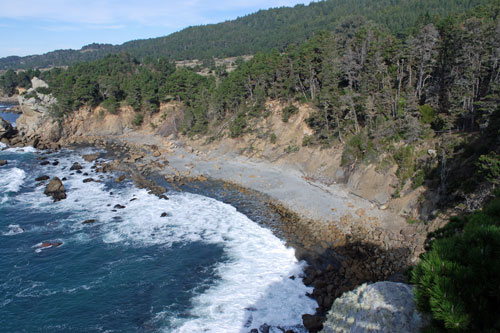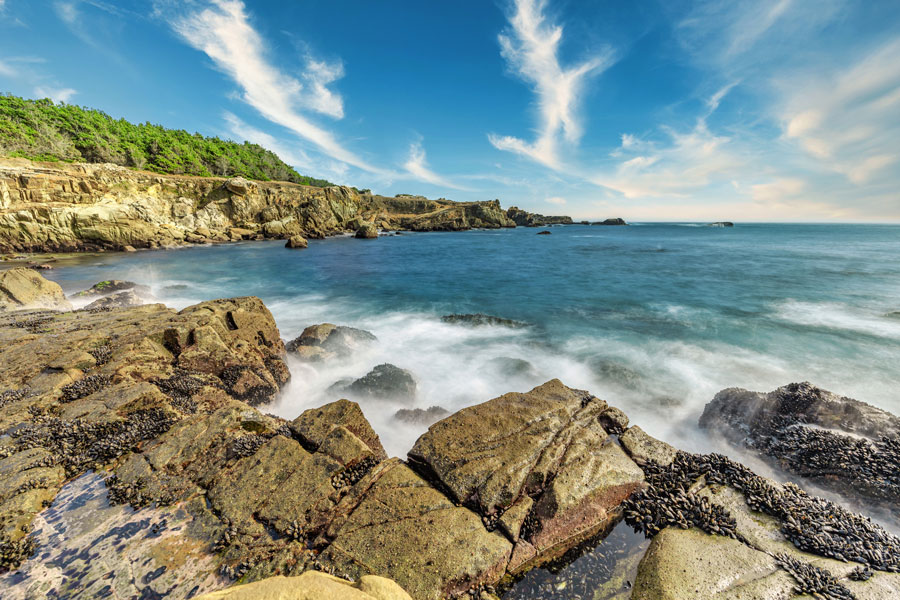Salt Point State Park Activities
Visitors to Salt Point State Park are rewarded with a spectacular 9-mile-long coast. Hiking and enjoying the amazing scenery are the most popular activities at the park.
Marine Plants and Animals
Visitors in late summer find the ocean near shore thick with bull kelp that has been growing at a phenomenal 10 inches per day. The kelp provides habitat for a variety a fish and other marine animals. Clinging to the rocks below the surface are red abalone. They take about 10 years to mature to a 7-nch diameter. During their winter migration, gray whales are commonly seen along the coast.
Caution: Before setting out, check with rangers that conditions are safe for your planned activities.
Inland Explorations
A number of trails lead inland through the park. Hikers pass from coastal grasslands and brush to dense forests of Bishop pine, madrone, and redwoods. The Pygmy Forest is a stand of trees stunted by the acidic soil and a hardpan layer just beneath the surface.
Animals hikers may encounter include squirrels, chipmunks, deer, coyotes, and raccoons. Less likely sightings might be of bobcats, badgers, and skunks.
Sea Kayaking at Salt Point
Several launch points are available for experienced sea kayakers around Salt Point State Park. Ocean Cove. Stillwater Cove, and Gerstle Cove and among the most commonly used. Swells of 8 to 10 feet are not uncommon and an occasional 20-footer can arrive. Morning tends to be the best time for kayaking with brisk winds picking up in the afternoon.
Free divers like the area around Fisk Cove, especially in a cove they call South Cove. just to the south of Fisk Cove. There a point of land and an offshore reef provide some protection from the incoming surf. In a shallow area there, divers encounter kelp beds, sea stars, and anemones. Beyond the reef are canyons and walls, a sandy bottom, and a variety of fish.

Fisk Mill Cove
Diving at Salt Point
Divers usually take advantage of the fairly convenient access at Gerstle Cove. The depth in the cove is about 30 feet with visibility up to 35 feet. Plenty of fish can observed in the cove along with jellies and brightly colored sea urchins. All marine life in the cove is protected.
Sonoma Coast Divers
Sonoma Coast Divers offers abalone diving classes along the coast north of Jenner. In the classes they teach about the equipment needed for free diving, identifying the shellfish, free diving techniques, and how to remove the abalone from the rocks. Most of the necessary equipment can be rented from them.
Shipwrecks along the Salt Point Coast
The freighter Norlina sank just outside Gerstle Cove in 1926. After salvaging most of the ship's general cargo, workers dynamited the hull. Remnants of the 386-foot-long vessel rest in 30 to 40 feet of water. Parts of it can be seen at low tide.
The schooner Bianca ran ashore at Salt Point in 1861. It was loaded with a cargo of wood. It is doubtful that remnants of the ship could still be located. Other ships that sank near Salt Point were the Ellen H. Wood in 1859, the Nautilus in 1877, the Mary D. Pomeroy in 1879, and the Phantom in 1881.
Fishing along the Salt Point Coast
Anglers find many great spots for fishing along Salt Point Park's rocky coast. Fishing is permitted throughout the area with a valid fishing license, with the exception of Gerstle Cove Marine Reserve and Stewart's Point Marine Reserve. The rest of Salt Point State Park is part of the Salt Point State Marine Conservation Area and the taking of finfish and abalone is permitted. Other marine life is protected.
Anglers have had great success using smelt, shrimp, squid, or mussels for bait. Among the usual catches are lingcod, cabezon, rockfish, and greenlings. Anyone fishing from the rocks should be extra vigilant and stay back from the waves' reach.
California Fishing Regulations
Kruse Rhododendron State Natural Reserve
The Kruse Rhododendron State Natural Reserve adjoins Salt Point State Park. Within the reserve are second-growth redwoods, Douglas fir, and an abundance of rhododendrons. The best time to visit is in May when the pink flowers are in full bloom. Five miles of trails wind through the Reserve. No dogs or bicycles are permitted in the Reserve.
Entry: Kruse Ranch Road off Highway 1, follow the road 1 mile to parking
Entry fees: None
Hours: Sunrise to sunset
Facilities: Parking, restrooms (may be closed due to park cutbacks), trails

